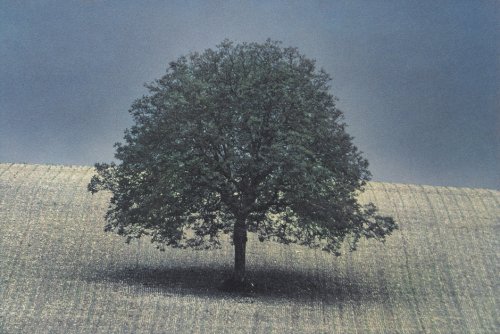A photographer at the keyboard : Frank Horvat
In l955 Frank Horvat, photographer and innovator, put fashion on the streets by taking natural pictures ofmodels outside. It is important to remember that fashionphotography was very stylized and artificial in those days. Pictures used to be taken in studios, under artificial lights, with set decors and fixed poses. Horvat thus began aminor revolution, comparable in its way to that of the Impressionists who set up their easels out-of-doors in realsettings.
Continuing along this line, Horvat now puts thestreet in his computer. For one year he has been digitalising his photographs and reworking them on the computer (see his photomontage on sports).However this new technique has not replaced his old friend, the camera, . In point of fact, Horvat’s photographs of Degas have just been published in book form by the French Imprimerie Nationale.
Paradoxically, Frank Horvat came to the computer for color, although he is best known as a black and white photographer. He has done color fashion photography, inaddition to several books of color work, particularly The Tree published by Aurum Press in London, with a text writtenby John Fowles..
Most photographers are attracted to computer pictures because they want to make solarizations, or reversal prints, or in order to do photomontages more easily. In this regard Frank Horvat is at the opposite pole. He uses the computer because he wants his photographs to look exactly as he wants, as IMAGES, and not conditioned by a medium (be it Cibachrome, Fresson, or something else). For Horvat the computer puts an end to the perennial debate over which pictures best suit which type of paper(for color printing).
« I began digitalising transparencies in order to have full control over color. In the beginning I transformedthe colors, then I moved around bits and pieces of the images. Finally, through this manipulation, I no longer hadto concentrate on the ’decisive moment’. »
And here we encounter another paradox of Horvat’s computer work. It is rare that a photographer, who had beena disciple of Cartier-Bresson and a member of the « Magnum team », chooses to work with a technique so totally opposedto the « decisive instant », that important moment when the photographer presses down the shutter.

« When one chooses new techniques, one gains but one also loses. The photographer has to invent new rules. Inthe same way that a 35 mm camera and the winder made the ’’decisive moment’’ disappear in favor of continuous photos dependent on random chance, the computer enabled me to gain certain advantages and lose others. »
Taking pictures with a 4x5 inch camera, or an 8x10inch camera made it impossible to take two pictures in an interval of fifteen minutes. There was no time allotted for mistakes. One had to snap the shutter at the right moment ;just the opposite is true of the 35mm camera because it is armed with a winder that can take four pictures a second. Frank Horvat believes that the tension created by the decisive moment is lost on the computer because the artistis in front of the screen constantly and has as much time as he wants or needs.
And yet, put another way, this decisive moment is not entirely lost because there comes a moment when everything finds its place. The artist knows the picture isgood, which means that all of its elements hang together in harmony. With a computer one can’t make a good photomontage out of bad images. By the same token, one doesn’t make a good photomontage just because the images are good, either. Horvat says : « It is necessary to have an idea, a project in mind. I don’t let the computer decide. For example, for the picture called »Minos« , my starting point was the idealized image I had of this girl. Then I looked into my files and »shuffled the deck« until I arrived at the right picture, after several tries. »
According to this photographer, the main advantage of a computer is its flexibility. For example, « Minos » could have been made with traditional techniques. Horvat could have mixed up his photos without a computer. He could have made a traditionnal collage. However, if one looks closely at the origins of all these photos, one comes to the realization that Horvat probably would never have thought ordared to put together such people, objects, and ambiances without the freedom afforded him by this tool. What strikesus in « Minos » is the diversity of the pictures used in the montage : geographic diversity, diversity of atmospheres, and also variations in time « Minos » was taken from a play(Laurence Olivier in « Titus-Adronicus » by Shakespeare). Ten years ago the Opera house was photographed for Vogue Magazine for the purpose of showing luggage. The girl came from a personal series called « Vraie-semblances » which was inspired by paintings. And that is exactly the point. One cant take an image through to its conclusion, using the imagination and putting on the finishing touches. One gains something by letting one’s self go completely with one’s imagination. Everything happens because the picture is not a transcription of the real -everyone knows that now- but rather an expression of the unity of time. Before the invention of the computer, when one looked at a photo, one could say : « All of that took place at the same time, »despite the fact that certain tricks did obscure some parts of the picture. Today, even the unity of time in a photo is no longer trustworthy, as demonstrated in my picture ’Minos’."
It is interesting to note that Frank Horvat rediscovered certain problems concerning painting through use of his computer. For example :
-that a person must have weight, i.e. a shadow, in order not to float away...
-that color requires finding the right filters and density and that this is not to the detriment of the ’decisive moment’ because time is always under control on a computer
-that the perspective will enable the different elements of the montage to cohere, and a program like « Photoshop » leaves room for corrections and modifications.
Faced with the difficulty of integrating the different elements, Horvat encountered several obstacles, which is why our computer illustrator returned to his camera in order to do his montage (See his picture about sports).After taking a picture of an « empty » Paris, he sought out a group of cyclists to complete his image. In the execution two problems emerged :
1) integrating the leafy trees with the bare trees : the solution he chose was to use one tree from his library of photos, then to extract it from the background of the photograph, transforming it three times and repeatedly pasting it on
2) incorporating the cyclists and the other people : a major problem because they lacked density and would not stay rooted to the ground. Adding a shadow was insufficient, and Horvat admits to not yet finding the solution. Elsewhere, as in the example of the bicycle, he replaced the spokes of the wheel by a transparent blur to get around.
In addition, Horvat learned how to integrate an element in the background by photographing it from far away. To integrate an element in the foreground he discovered itis better to photograph it nearby. Errors in the perspective can be somewhat modified. Thus Horvat discovered what appears to be an important rule for the cohesion of his work.
In conclusion, let Horvat speak for himself : « What I gain from the computer is an immense physical pleasure that I don’t get from the lab, whether my work is in blackand white or in color. By physical pleasure I mean adding to my own possibilities by means of a program with the beauty of »Photoshop« . Its intelligence charms me. I will end by saying that the computer renewed my desire to go out again to take ’real pictures’. In similar fashion, the Impressionists began doing new things when photography was invented. The computer will give youth back to photography. »
Text : Hervé BERNARD
Adaptation in english : Harriet LIENS
This article was published in Le Photographe in 1991
 Regard sur l’image
Regard sur l’image


